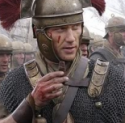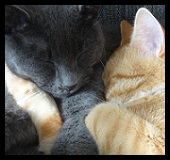|
Hey, speaking ofWoodrowSkillson posted:Granted their idea of a boot is what we would call a sandal with extra straps. Did they ever use boots or shoes that were closer to our conception of them? I imagine the Gauls would have had proper boots due to living in much colder climates, and the idea of wrapping leather around your feet with a hard bottom is not a super complicated idea. BoutrosBoutros posted:I don't know man, that seems a bit like asking why didn't Romans wear T-Shirts. They had different types of shoes, but they were basically all sandal-ish. The military caligae weren't any less advanced than those boots you posted either. In some ways they were better. They were more durable since there was much less stitching, and being more open meant you wouldn't get blisters or trenchfoot as easily. If it was cold they wore socks under them, no big fashion faux-pas about it back then. The shoes they had worked for them. euphronius posted:Pretty cool screen shot from a link in Komet's post I'm curious about socks, too. I don't know if they had knitting in the way we think of it. All their textiles I know about (not an expert) are woven. I'm having a hard time imagining good woven socks.
|
|
|
|

|
| # ? May 9, 2024 21:13 |
|
Anne Whateley posted:Hey, speaking of Those are actually Calcei Senatorii which were a type of closed toe shoe the Romans had. They were traditionally black leather, which is what you see on that colorized statue. Even these were a little bit sandal-y with some weird straps that wrapped around your foot and ankle to hold them on, rather than laces or something like that. EDIT: I don't know how legit this source is so maybe take it with a grain of salt, but here's a page that explains some different types of footwear: http://www.vcrv.ch/downloads/Shoes-Roman.pdf BoutrosBoutros fucked around with this message at 06:44 on Oct 31, 2012 |
|
|
|
How come the Roman's wore leather panties? Seems kind of dumb to be doing athletics in hot, sweaty leather on your sensitive parts. I would imagine that gladiators had really bad jock itch and yeast infections.
|
|
|
|
Anne Whateley posted:I'm curious about socks, too. I don't know if they had knitting in the way we think of it. All their textiles I know about (not an expert) are woven. I'm having a hard time imagining good woven socks. Assuming that the information on Wikipedia is accurate, then they've been a thing as far back as classical Greece. But I guess they were foot wraps more than anything else. Though I do remember when I was in high school, we were watching a video on Pompeii and one of the historians speaking mentioned something about a sock that was worn by a little kid or infant. This was way back in 2003, so I don't remember much about it. That's also the same video I saw when I learned that the Romans regarded the people of Britain as loving crazy and got the hell out. I don't look back on my high school world history class very fondly. I had to take a year of Latin (where I learned the wonderful story of how vestal virgins were punished for being tainted) and a year of art history classes to undo an awful lot of the damage. My US history teacher was even worse, but anything I learned about Rome was whatever was going to be on the test and not anything of interest. I do remember him musing about the idea of what could of happened if Rome and China had ever ended up in a fight. And speaking of bullshit about Roman history, something I want to know is how in the hell did Joseph Smith come up with the idea of Rome having contact with Native Americans when he was writing the Book of Mormon? I imagine that he made it up from whole cloth, but was it purely his own idea or was there some kind of weird, romanticized (hurr hurr) idea of Rome in the American mindset in the 1830s? I mean, I think it's plausible that Rome could have ventured into the Americas the same way Leif Eriksson ended up in Newfoundland by sailing from mainland Europe to Iceland, then to Greenland, and then to Canada (though their boats probably never could have handled the voyage or the climate). Star Man fucked around with this message at 07:00 on Oct 31, 2012 |
|
|
|
I'm not well-versed in Mormon mythology, but pretty sure Joe Smith said it was converted Jews, not Romans, that contacted the Amerindians. As an aside, does anyone really wish that there was some kind of contact between the ancient Mediterranean and the New World? Carthagayans/Mayaginians would kick everyone's rear end in Age of Empires.
|
|
|
|
You're right, it would have been converted Jews. Whenever I think of Old World contact the the Book of Mormon claims to have happened, I keep misremembering what the story is from what I watched in this video, which depicts people that look like stereotypical Roman centurions fighting Native Americans*. *god dammit, I'm from Wyoming and the norm is to say Indian, even though I know the difference and that calling them Indians errs on the side of racism. Native American/Amerindian just feels so unwieldly.
|
|
|
|
My Cherokee family prefers Indian to NA for what it's worth. But, derail. Joseph Smith just pulled it out of his rear end I'm sure.
|
|
|
|
I thought so. Joseph Smith wrote the Book of Mormon during a time when other batshit crazy ideas like a hollow earth were being kicked around. I was more curious if he made it up himself or if someone or something he read planted the idea in his head. And speaking of a hollow earth, while I was reading the lengthy backlog of this thread, I came across your post that the Roman idea of the extreme south was hot. Obviously, they got that idea because their concept of the far south was the Sahara, but it reminded me of Edgar Allen Poe's The Narrative of Arthur Gordon Pym of Nantucket. The second half of the novel deals with the exploration of the extreme southern latitudes, and while the novel was a hoax, it did describe the land that is found there to be really hot. I doubt that Poe had the same concept the Romans did of the far southern latitudes in mind, but it was one of those moments where I could think to myself, "hey, I've heard of this idea before."
|
|
|
|
There are some fringe theories relating to claimed objects of Roman origin in the Americas, in particular this terracotta head. I think it postdates Smith. Anything interesting known by archaeology about prehistoric Latins? ptk fucked around with this message at 08:47 on Oct 31, 2012 |
|
|
|
ptk posted:Anything interesting known by archaeology about prehistoric Latins? I second this question. I remember my Latin teacher telling my class that sometimes, the Romans would want to build something in the same place that their ancestry or an earlier people in the area that the city was in was. The attitude was to leave it alone because it was put there by the ancestors and to build around it or over it. They would even go as far as completely burying the object, but would still try to preserve it.
|
|
|
|
Cervixalot posted:Caracalla was another. Like Caligula, referred to an article of clothing (in this case, a hooded cloak) that he wore often. IIRC in The History of Rome its mentioned as never being used in his presence due to his distaste for it.
|
|
|
|
Lonely Virgil posted:How come the Roman's wore leather panties? Seems kind of dumb to be doing athletics in hot, sweaty leather on your sensitive parts. I would imagine that gladiators had really bad jock itch and yeast infections. I'm going to guess that athletes went naked, like in Greece.
|
|
|
|
Anne Whateley posted:I'm curious about socks, too. vvv or it's a letter from his mum, whatever vvv physeter fucked around with this message at 15:02 on Oct 31, 2012 |
|
|
|
Vindolanda Tablet 346 posted:"... I have sent (?) you ... pairs of socks from Sattua, two pairs of sandals and two pairs of underpants, two pairs of sandals ... Greet ...ndes, Elpis, Iu..., ...enus, Tetricus and all your messmates with whom I pray that you live in the greatest good fortune." 
|
|
|
|
Salve Mater, Salve Pater. Here I am at castra hiberna
|
|
|
|
Here is something that confuses me: Some writings about the retiari gladiators persistently mention that they were seen as weak and effeminate in connection with being clad in a tunic. Didn't lots of Roman men wear a tunic rather than a full toga much of the time? Did the Romans have a more narrow and specific definition of what they considered a tunic, whereas we'd call any man's garment that stretches below the waist a tunic?
|
|
|
|
Halloween Jack posted:Here is something that confuses me: Some writings about the retiari gladiators persistently mention that they were seen as weak and effeminate in connection with being clad in a tunic. It is understood that some retiarii that fought clothed instead of mostly naked, I think that's what you're referring to? Traditionally the retiarii were seen as the lightweights on the sand, the effeminate ones compared to the heavier secutores. Perhaps you're reading a connection between being clothed in a tunic and womanishness, but I'd say it's a false lead. It's the being a retiarius that would offend Roman manliness, not their wearing of a tunic.
|
|
|
|
Were there any kind of jackets, fur coats or something of the sort? Every image and description of the typical Roman seems perfect in the summer but those clothes would be awful to wear during the winter, specially in the cold, snowy winter of Italy.
|
|
|
|
physeter posted:It is understood that some retiarii that fought clothed instead of mostly naked, I think that's what you're referring to? Traditionally the retiarii were seen as the lightweights on the sand, the effeminate ones compared to the heavier secutores. Perhaps you're reading a connection between being clothed in a tunic and womanishness, but I'd say it's a false lead. It's the being a retiarius that would offend Roman manliness, not their wearing of a tunic.
|
|
|
|
Mans posted:Were there any kind of jackets, fur coats or something of the sort? Every image and description of the typical Roman seems perfect in the summer but those clothes would be awful to wear during the winter, specially in the cold, snowy winter of Italy. There were heavy cloaks, socks, leg wrappings, hats. They also layered the tunics. Pants were a bit of a problem as they were seen as barbarian clothing, but I'd wager people in cold areas would adopt the local dress and wear them.
|
|
|
|
Grand Fromage posted:There were heavy cloaks, socks, leg wrappings, hats. They also layered the tunics. Pants were a bit of a problem as they were seen as barbarian clothing, but I'd wager people in cold areas would adopt the local dress and wear them. I remember reading, possibly in this thread, that most of the legionaries on Britain and Germany wore trousers?
|
|
|
|
Beardless posted:I remember reading, possibly in this thread, that most of the legionaries on Britain and Germany wore trousers? I don't know if there's evidence for it but I'd assume they did given the climate. They might be barbarian clothing but if it's that or literally freeze your balls off, time to put on some pants.
|
|
|
|
So perhaps there is something to that whole stereotypical look of the Romans in movies. And speaking of movies, I won't be surprised if a person like yourself eats a whole hat store whenever you watch The Passion of the Christ. I remember one of my two teachers in a film and religion class mentioning that one of Pontius Pilate's aids said something like "will you get my laundry?" to him rather than what the caption said in Latin.
|
|
|
|
Grand Fromage posted:I don't know if there's evidence for it but I'd assume they did given the climate. They might be barbarian clothing but if it's that or literally freeze your balls off, time to put on some pants. I have no memery of where I read it, but I recall reading that the Rhine and British legions adopted trousers from the local guals because of the harsh winters compared to Italy. This was especially prevalent one Gaul fully assimilated and the full legionaries were Gaulish by heritage.
|
|
|
|
physeter posted:It is understood that some retiarii that fought clothed instead of mostly naked, I think that's what you're referring to? Traditionally the retiarii were seen as the lightweights on the sand, the effeminate ones compared to the heavier secutores. Perhaps you're reading a connection between being clothed in a tunic and womanishness, but I'd say it's a false lead. It's the being a retiarius that would offend Roman manliness, not their wearing of a tunic. Speaking of effeminate gladiators: What about them Gladiatrix? I've read the wiki, but beyond that I've not found much information. Rich girls having a jolly good time as a side show to the main deal (fighting dwarves or what have you) or... ?
|
|
|
|
Pimpmust posted:Speaking of effeminate gladiators: What about them Gladiatrix? So on top of this strange social niche, you also have history's general habit of not recording the lives of commoners, and especially those of common women, and so there's not a huge amount of info beyond what I can say about gladiators themselves. Actually this social duality was common in just about every trade that now constitutes our celebrities: actors, artists, dancers, musicians, etc. Artisitic celebrity in the Roman world might get you laid and paid, but middle class was as far as you were going on the social ladder.
|
|
|
|
I know drawing comparisons is not good scholarship but I think their views on gladiators is pretty close to to the view on pro athletes today in many ways. Certainly not exactly the same but I don't think it's unrecognizable.
|
|
|
|
Star Man posted:So perhaps there is something to that whole stereotypical look of the Romans in movies. The dialogue sounded more like broken Italian read in an American accent. But I did laugh when one soldier orders another to go. "I! I!!!"
|
|
|
|
Baron Porkface posted:Did the Romans think Italy looked like a boot? I've only seen "oak leaf," in Pliny the Elder ptk posted:Anything interesting known by archaeology about prehistoric Latins? What do you want to know, exactly? I mean there's evidence of what's known as "Latial culture" from c. 1000 BC that is the same sorts of grave goods and types and settlement patterns. I really like this form of cinerary urn, called a "hut urn." Eggplant Wizard fucked around with this message at 01:02 on Nov 3, 2012 |
|
|
|
Abusing my mod privilege to attach an image to this post instead because the other one was HUGE and I can't edit the attachment, only remove it.
|
|
|
|
Wow, that's new for me. What's the sculpture on top? Looks like someone hired HR Giger to design a Beni-Hana restaraunt. Love it.
|
|
|
|
Can someone help me with this? I've never been able to wrap my head around how the maniple system functioned. I understand how such a formation would intrinsically be more maneuverable and able to adapt to changing conditions on the battlefield, but what I've never been able to grasp is how they were able to plug the "holes" between each maniple. For example, if facing a phalanx or other arrangement where the opposing side consisted of a single solid front, what happened in the gaps between maniples? My imagination leads me to believe that the opposing troops not facing a maniple formation would swarm in against the sides of the forward maniples or push onward toward the 2nd line of maniples, which in both cases would force the second line of maniples to push forward in effect turning the entire formation into a phalanx with an oddly spaced reserve in the rear. I'd love to finally understand what it was about Rome's military formations that made them the elite of the Mediterranean.
|
|
|
|
physeter posted:Wow, that's new for me. What's the sculpture on top? Looks like someone hired HR Giger to design a Beni-Hana restaraunt. Love it. I love hut urns! Basically they are just little models of the types of houses the Villanovans lived in.
|
|
|
|
I think it's a cool idea. It's probably meant to be a home for your soul to live in or something. Or maybe it's meant to represent your home in the afterlife.
|
|
|
|
Pimpmust posted:Speaking of effeminate gladiators: What about them Gladiatrix? There really isn't that much information. We know they definitely existed. They were very rare, and consequently a big draw if you had it as part of your show. And then... not much. I just skimmed the wiki article and I have nothing to add, that sums up what I know about them. Steriletom posted:Can someone help me with this? I've never been able to wrap my head around how the maniple system functioned. A lot of this kind of detail is speculative because Roman authors didn't explain it. They assumed their audience was already familiar with these kinds of things (which they were) so they didn't waste a lot of time on it. Makes total sense for the writers, but leaves us frustrated. So with in mind that THIS IS SPECULATION and there is plenty of disagreement on the details of Roman battle formations, here is what I learned. The power of the maniples was that they could move around without loving up your line of battle. This is what the Macedonians did that made their phalanxes superior. The primary weakness of the phalanx is it is the least maneuverable formation ever. It's very strong from the front, but if you hit it from any other angle it is hosed. So say you have a phalanx against a Roman line of battle.  Both sides advance and meet.  Now, the phalanx has two options. The best defensive course is to stay in a tight line, even though some of the soldiers aren't being engaged. But these are good fighting men who want to kill. They advance!  They begin to engage the second line.  Whoops, you're hosed. The flanks are open, while the second line is keeping the phalanx occupied you can hit either side of it and roll it. They have no defense. Third line takes advantage of this and hits the flank. There's really nothing they can do about it, and once one flank begins to roll up they can just keep going until the phalanx breaks.  But Romans didn't always deploy the same formation. Our general here knows his poo poo, he studied the Battle of Cannae well. He spreads his men out, enough to hold the line but with a weak center. Our phalanx's commander falls for it.  Whoops, you're hosed again. There's nothing the phalanx can do, you can't turn to meet this attack without breaking the entire formation. I'm not saying this is Standard Roman Battle Tactics or anything, but hopefully it gives you an idea of what maniples were all about.
|
|
|
|
Steriletom posted:Can someone help me with this? I've never been able to wrap my head around how the maniple system functioned. - Superior maneuverability (a given) - Harder to break, superior for morale. An army with one line will rout when that one line breaks. But the maniples were many lines. One could break and the rest of the army could stand fast. - Only the best cavalry will follow through in a head on charge. The gaps would have dissipated the force of most frontal cavalry charges. This definitely happened with the elephants at Zama. - The manipular deployment LOOKS weaker than a single line. This is so important, and so rarely understood. The reality of classical warfare is that most battles must occur by consent. If the other side doesn't want to fight, they can just not give battle. Fabian strategy is based on this. So if you're looking to conquer without battling a protracted insurrgency or dealing with a siege, the enemy needs to be brought to battle against your superior force, and beaten badly. An enemy might have scoffed at the ragged looking frontliners and swarmed into the gaps, then the second line came up and then they were caught like meat in saw blade. Surrounded on three sides, retreat became difficult. This is a tough one to grasp today, where in simulations we always have a good idea of enemy deployments and numbers. Ancient commanders had some scouts, a hill and maybe a rough idea of how many guys were on the other side. This is highly speculative on my part, but I wouldn't be surprised if the manipular deployment was a psychological feint meant to encourage an unsuspecting, numerically superior foe to give battle against a smaller, more highly trained force. Which is what the Romans were, so, it makes sense to me.
|
|
|
|
physeter posted:- The manipular deployment LOOKS weaker than a single line. You know, I don't think I've read this before but it makes a lot of sense. Think about that the Romans were constantly coming up against new groups of people. Intelligence gathering in the ancient world was spotty at best, so most of the time these new groups wouldn't know what they were up against. They certainly would've heard rumors about what the Romans could do but most likely didn't really know. I can see some commander looking at a spotty, jagged line of Roman soldiers armed with a bunch of pussy little short swords and thinking psh, these Romans ain't poo poo.  From reading the history, going into battle against a legion without knowing what you were up against rarely went well. Part of the reason the later Roman army started getting beaten more and more often was that their enemies had served in it and knew how a legion operated. That starts at the Teutoburg Forest and keeps getting worse with time.
|
|
|
|
Exactly. The front end of the maniples, seen from a tree top and half obscured by dust or rain looks disorganized and unformed. "I'm weak, attack me here, commit your line." An hour later he can't disengage to rest without heavy casualties, and it's over soon enough. The evolution of the maniples also coincides well with the period before the Romans much good at siegecraft, making the decisive win on the field all the more important.
|
|
|
|
edit: actually I'm not confident enough in my own knowledge to say what I tried to say.
NLJP fucked around with this message at 04:13 on Nov 3, 2012 |
|
|
|

|
| # ? May 9, 2024 21:13 |
|
My understanding of the power of the maniple was that it creates much more flexibility in rough terrain. The phalanx was developed specifically for the flat plains of Greece. A city-state could put together one big unflankable line, and walk forward in formation. It was highly effective because anyone who didn't follow the same strategy would end up on the business end of a 9-foot pike. However, the world isn't filled with Marathons and Thessalys, and so more often than not you had to retreat until you could find proper terrain to do it. This is why Greek battles tended to be fought in the same locations war after war. Now this was all well and good for the Greeks who had nothing better to do, but the Romans weren't about to hike all over Italy on account of trees being in the way. They'd just as well get stuck in, and then both sides would have to deal with the complexities of terrain flanking. With their checkered formation and independent officers, the maniples would do just fine at this bit, whereas the phalanx armies would be busy unfucking themselves after bumping into a creek or something. And if it came to a traditional line battle, the maniple could easily slot themselves in there too (complete with triarii veterans in the rear with proper pikes). Kaal fucked around with this message at 05:03 on Nov 3, 2012 |
|
|



 i like nice words
i like nice words




























